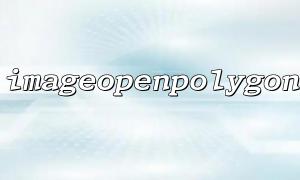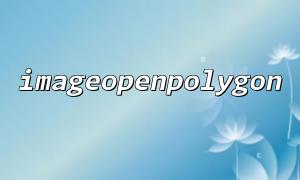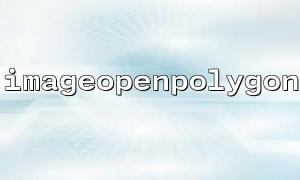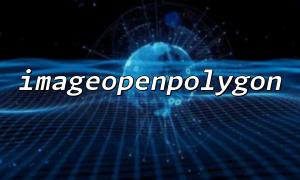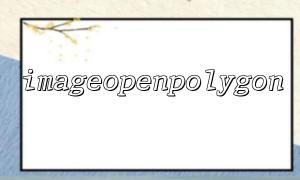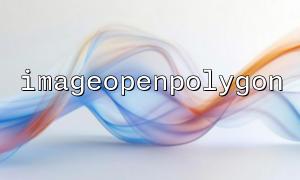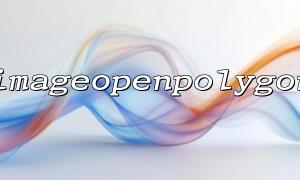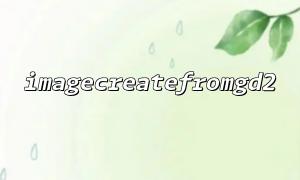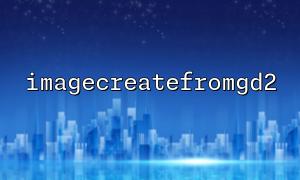在PHP中, imageopenpolygon()是一個非常實用的函數,它可以用來繪製開放的多邊形線條。在小規模繪圖時,這個函數表現良好,但當涉及大量點或大規模繪圖任務時,其性能瓶頸就會逐漸顯現。本文將探討一些提升imageopenpolygon()在大規模繪圖中性能的方法。
imageopenpolygon()接受一個點數組,通常是一個一維數組,形如[x1, y1, x2, y2, ..., xn, yn] 。在生成這些點數據時:
盡量預先生成所有點,避免在調用imageopenpolygon()時動態計算。
確保數組是緊湊的,沒有多餘的空值或重複點。
// 不推薦:動態生成點
$points = [];
for ($i = 0; $i < 1000; $i++) {
$points[] = rand(0, 500);
$points[] = rand(0, 500);
}
imageopenpolygon($image, $points, count($points) / 2, $color);
// 推薦:提前準備好的固定數組
$points = generatePoints(); // generatePoints()內部返回一個優化過的一維數組
imageopenpolygon($image, $points, count($points) / 2, $color);
如果你的繪圖中存在大量重複或相似的多邊形,可以考慮:
將生成的點數組緩存到文件或內存中(如使用Redis)。
在每次繪圖時復用這些數據,而不是每次重新生成。
$cacheKey = 'polygon_points_large';
$points = apcu_fetch($cacheKey);
if ($points === false) {
$points = generateLargePolygonPoints();
apcu_store($cacheKey, $points);
}
imageopenpolygon($image, $points, count($points) / 2, $color);
注意:使用APCu緩存需要服務器啟用APCu擴展。
在大規模繪圖時,不一定每一個細節都需要精確展現,適當簡化點集合可以極大提升性能:
使用抽稀(decimation)算法減少點數量。
根據縮放級別動態決定採樣率。
簡單的點簡化示例:
function simplifyPoints(array $points, int $threshold = 5): array {
$simplified = [];
for ($i = 0; $i < count($points) - 2; $i += 2) {
if ($i % ($threshold * 2) == 0) {
$simplified[] = $points[$i];
$simplified[] = $points[$i + 1];
}
}
return $simplified;
}
$originalPoints = generateVeryLargePolygon();
$points = simplifyPoints($originalPoints, 10);
imageopenpolygon($image, $points, count($points) / 2, $color);
雖然GD庫內置於PHP且方便使用,但在極端繪圖需求下,GD的性能可能不足。可以考慮:
使用Imagick (基於ImageMagick的PHP擴展),它在大規模圖形處理上性能更優。
結合CLI方式調用專門的繪圖程序(如通過shell_exec()調用ImageMagick命令)。
示例使用Imagick:
$draw = new ImagickDraw();
$draw->setStrokeColor('black');
$draw->setFillColor('none');
$draw->setStrokeWidth(1);
$draw->polyline([
['x' => 10, 'y' => 10],
['x' => 100, 'y' => 30],
['x' => 50, 'y' => 100],
]);
$image = new Imagick();
$image->newImage(200, 200, "white");
$image->drawImage($draw);
$image->setImageFormat("png");
$image->writeImage('/var/www/html/uploads/output.png');
如果繪製的內容非常大,可以考慮將畫布分成多個小塊(Tile),分別繪製後再合成:
每次只繪製可見區域。
減少一次性內存開銷。
function renderTile($startX, $startY, $width, $height, $points) {
$image = imagecreatetruecolor($width, $height);
$background = imagecolorallocate($image, 255, 255, 255);
imagefill($image, 0, 0, $background);
$color = imagecolorallocate($image, 0, 0, 0);
$tilePoints = filterPointsForTile($points, $startX, $startY, $width, $height);
if (!empty($tilePoints)) {
imageopenpolygon($image, $tilePoints, count($tilePoints) / 2, $color);
}
return $image;
}
通過這種方法,可以極大減少每個繪圖動作的負擔,提升整體性能。
